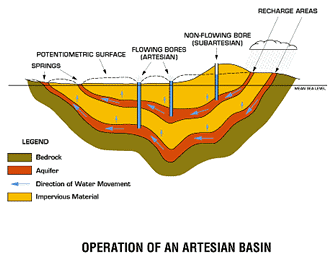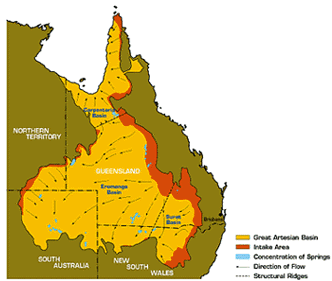The traditional view of the Great Artesian Basin, which is the basis of government policies and which is taught in schools, is that the aquifer is a porous rock where the water content is continuously replenished by slow seepage from the strata outcrops in the uplands to the east. This concept is incorrect and the resulting mis-management of the Basin is causing irrecoverable damage to this valuable asset.
As a result the assessment of potential life of the groundwater resource is wrong and hopelessly optimistic with a volume of water equal to 80% of Sydney Harbour wasted each year, equivalent to annual economic output of $14 billion.
Substantial and permanent damage is being done to the aquifer by the present uncontrolled usage. The economic cost is so great that the costs of immediate correction are trivial by comparison.
Advertisement
This is a matter of such vital importance to the national economy that there can be no question of insufficient funds.
The present conceptual model of the characteristic behaviour of the Great Artesian Basin is that of an open system. This conceptual model is shown in the Queensland government web page - www.dnr.qld.gov.au/resourcenet/water/artesian_basin/flow.html.
The accompanying illustrations are taken from that webpage.

The concept of an open system assumes that as water is withdrawn from the aquifer it can be replaced by lateral transfer from recharge areas or from elsewhere in the basin. The concept looks plausible in the diagram, which has been drawn to a grossly exaggerated vertical scale.
However, the depth to the aquifers is some 500 to 1000 metres, and the lateral extent of the Basin is some 1000 by 1500 kilometres. If the above diagram were to be drawn to a natural scale, it would show only as a single line across the page.
Advertisement

Because of the huge lateral extent of the Great Artesian Basin, that covers 1.7 million square kilometres, there are virtually no prospects whatsoever for lateral transfer from recharge areas.
It is also assumed that the withdrawal of water causes no change in the physical dimensions or characteristics of the aquifer.
Discuss in our Forums
See what other readers are saying about this article!
Click here to read & post comments.
2 posts so far.
About the Author
Emeritus Professor Endersbee AO FTSE is a civil engineer of long experience in water resources development. His early professional career included service with the Snowy Mountains Hydro-Electric Authority, the Hydro-Electric Commission of Tasmania and the United Nations in South-East Asia as an expert on dam design and hydro power development. In 1976 he was appointed Dean of the Faculty of Engineering at Monash University. In 1988-89 he was Pro-Vice Chancellor of the University.
His fields of specialisation include the management of planning and design of major economic development projects, water resources, energy engineering and transport engineering. He has been associated with the design and construction of several large dams and underground power station projects and other major works in civil engineering and mining in Australia, Canada, Asia and Africa. He was President of the Institution of Engineers, Australia in 1980-81.
In 2005 he published, A Voyage of Discovery, a history of ideas about the earth, with a new understanding of the global resources of water and petroleum, and the problems of climate change.